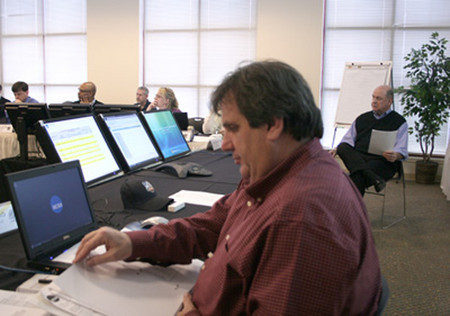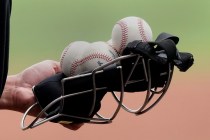Committee picks mock NCAA Tournament bracket
INDIANAPOLIS -- It has been a long day and everyone's tired.
Eighteen writers, broadcasters and conference officials have convened at the NCAA offices to simulate in two days what the men's basketball committee does in five -- that is, to select, seed and bracket 65 teams to play in this year's NCAA Tournament.
It's Thursday and we're nearly nine hours into the process, trying to winnow the field to 65, and we're not even close to being done. That's not going to happen until Friday afternoon.
When we're done, three Mountain West teams, including UNLV, are in the NCAA field. North Carolina, Connecticut and Louisville, welcome to the always thrilling NIT; pick up your lovely tote bags before you leave.
In our mock NCAA bracket, the Rebels are a No. 6 seed in the Midwest (St. Louis) Regional and will face No. 11 Old Dominion in the first round at New Orleans. New Mexico is a No. 4 seed and Brigham Young a No. 5.
The NCAA began holding this mock exercise in 2007 in an attempt to educate the media about the selection process and erase myths about the weight given to certain criteria -- such as the Ratings Percentage Index or conference affiliation -- by the real selection committee. In our two days in the room, not once did anyone mention the number of bids given to teams from a particular league.
The mock selection is real in every way except the most obvious (ours doesn't count). The room is set up the same, though the real committee's accommodations are swankier. We're using the same computers with access to the same information, including the RPI. The stats we used were current through last Wednesday.
Like the real committee, we have NCAA staff on hand to answer questions or troubleshoot problems. Greg Shaheen, NCAA vice president of the Division I basketball tournament, believes the mock bracket is 99 percent accurate to the real one selected every year in mid-March on the 15th floor of the Indianapolis Westin Hotel.
Unlike the real committee, which has 10 members, this committee has 18. We were supposed to have 20, with two assigned to each real committee spot, but bad weather kept two mock members from attending. Two years ago I was assigned to portray Utah athletic director Chris Hill. This year I've moved into the chairman's spot with CBS Sports college basketball producer Steve Scheer, and we're filling the role of UCLA athletic director Dan Guerrero, the real chairman.
For better or worse, Scheer and I are the face of the committee. When the bracket is complete, it is the chairman who must face the TV cameras and explain why one team was chosen over another, why this team was seeded where it was, and why one team was sent West while another was allowed to stay in its home state through the entire regional.
When I asked Guerrero what to expect, he said: "You're working with a script the NCAA gives you. Just follow the script and keep things moving and you'll be fine."
Easier said than done. You're dealing with diverse personalities, a few big egos in the room and different philosophies about who belongs and who doesn't. Some members favor strength of schedule when considering the merits of at-large qualifiers. Some trust RPI. Some care about a team's last 12 games, while others don't. Some think road wins count more. Others think good losses matter. As chairman, my objective is to get the committee to speak as one voice.
I found the chairman's job to be like a mix of jury foreman, orchestra conductor and jockey. The jury foreman seeks unanimity. The orchestra leader wants harmonic perfection. The jockey tries to push the horse to run a little harder and get to the finish line in good time.
With Scheer going to the whip, we prod and cajole and make good progress Thursday. The top four lines of the bracket are seeded and most of the 34 at-large bids are assigned.
Shaheen tells us we're peeling an onion, layer by layer, until we complete the at-large field. We finally finish that portion Friday morning when all conference tournaments are complete, settling the 31 automatic bids.
In our bracket, the last four teams to get in are Saint Mary's (Calif.), Charlotte, South Florida and Florida. The bubble has burst for Alabama-Birmingham, Texas-El Paso, Siena and California. They'll all be awaiting an explanation.
As chairman, I help initiate discussion about teams, seeding and bracket location. I don't dominate the room, the exact opposite of what I thought takes place on the real committee. In two days, I didn't have to say a lot other than to trigger discussion or remind the rest of the committee to wrap up what seemed like an endless number of votes we took.
The seeding process goes smoothly. The top four seeds are Kansas, Syracuse, Kentucky and Villanova. We don't have a lot of argument about where to seed most of the field other than a spot or two. All seeding, as well as selection, is done by secret vote on the computer.
Things get dicey when it's time to bracket, because the NCAA has rules that must be followed. No teams from the same conference can play each other until a regional final; rematches must be avoided, both from the regular season and the previous five years of the tournament. That explains why the bracketing often comes out looking weird.
Somehow we make our 2 p.m. deadline for producing a bracket and we leave feeling good about what we accomplished.
Me? I am just relieved I don't have to answer questions about why Florida got in and Siena didn't. I'll leave that pleasant task to Dan Guerrero on March 14.
Contact reporter Steve Carp at scarp@reviewjournal.com or 702-387-2913.
Download PDF of bracket
THE "COMMITTEE"
Members of the 2010 NCAA mock selection committee:
Steve Carp, Las Vegas Review-Journal and Steve Scheer, CBS Sports (co-chairs)
John Akers, Basketball Times
Tom Akins, Associated Press Radio
Dave Birkett, AnnArbor.com
John Bohenenkamp, The Hawkeye
Eamonn Brennan, ESPN.com
John Clay, Lexington (Ky.) Herald-Leader
Dan Gavitt, Big East Conference
Clark Kellogg, CBS Sports
Scott Leykham, West Coast Conference
Kevin McNamara, Providence Journal
Jerry Palm, CollegeRPI.com
Bill Rabinowitz, Columbus Dispatch
Will Roleson, Horizon League
Shannon Ryan, Chicago Tribune
John Underwood, Big 12 Conference
Lindsey Willhite, Daily Herald (Arlington Heights, Ill.)

















